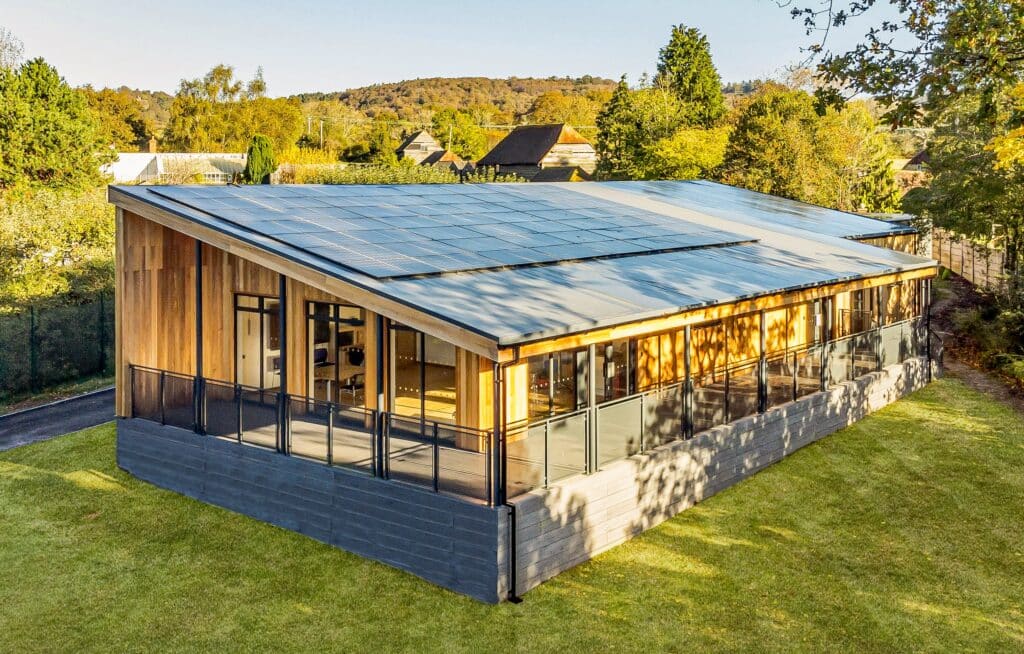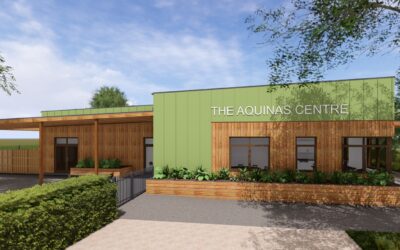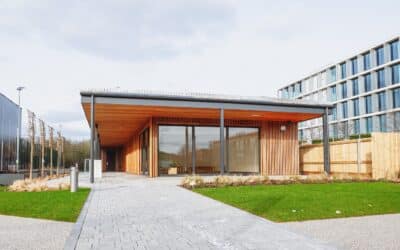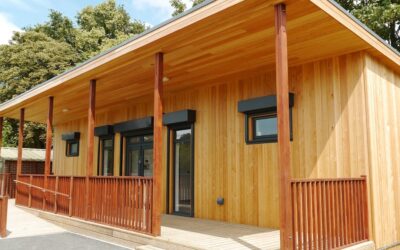TG Escapes Blog
Meeting Changing Needs with Modular SEND Buildings
In SEND (Special Educational Needs and Disabilities) environments, flexibility is crucial, with each child requiring different considerations in terms of space, design, and functionality. With a crisis in SEND placements gripping the UK, any new spaces we build must be able to meet the complex needs of different pupils, and grow over time should pupil intake increase. Traditional construction methods often struggle to keep pace with these changes, in terms of both cost and time.
Modular buildings offer a flexible, cost-effective solution, allowing schools to tailor and expand their learning environments quickly while meeting the ever-changing needs of their students.
One size doesn’t fit all in SEND

SEND education within the UK is currently in a complex crisis involving funding, placements, and regulations. A recent investigation revealed that 58% of SEND pupils had taken time out of school because their needs could not be met, and while the government has committed to creating 60,000 new special needs places, these spaces need to be designed around all current and future needs.
SEND encompasses a wide range of conditions, each requiring different considerations in terms of space and environment. From additional noise insulation to specialised lighting, the requirements for SEND pupils can vary dramatically. In both specialist and mainstream schools, these needs will change as new pupils join, each bringing their own unique requirements.
Once added, space can quickly become insufficient, especially in mainstream schools that often struggle to accommodate growing pupil numbers. When it’s time to expand, adding to traditional brick-and-mortar buildings can be a lengthy and costly process, making it difficult for schools to adapt as needs change over time.
How modular school buildings can be tailored over time
Modular buildings are constructed using prefabricated panels that are designed off-site and assembled quickly on location. The panelised approach allows for customisation at every stage, offering schools the ability to adapt classrooms as pupil needs evolve, ensuring accessibility, lowering sensory stimulation, and improving overall academic performance and happiness. Expanding these buildings is also far simpler than traditional brick-and-mortar extensions, helping schools grow and adjust with ease to meet both current and future demands.
Changing learning areas to meet pupil needs
SEND covers a wide range of needs, from physical disabilities to autism, making the ideal classroom for SEND children highly variable. What is perfect for one year of students might be unsuitable for the next, making malleability crucial. Modular buildings designed with SEND in mind can offer the flexibility to accommodate these changes over time.
Some examples of how modular buildings can meet these changing needs include:
- Changeable spaces: Modern educational buildings can offer a range of specialist facilities alongside traditional classrooms. Multi-purpose spaces can be designed from the ground up to work as classrooms, workshops, performance spaces and more.
- Moveable partitions: Designing larger spaces with movable partitions allows classrooms to be divided into multiple spaces as needed, or expanded for students with limited mobility.
- Noise insulation: While not all SEND pupils are uniquely sensitive to noise, those with sight impairment and autism are particularly affected by high levels. Acoustic insulation can be incorporated throughout classrooms to make sure that pupils will always be comfortable, and insulation levels can also be augmented over time with acoustic panels.
- Breakout rooms: Many SEND buildings attach breakout spaces to regular classrooms, offering a dedicated area for everything from one-to-one interventions to sensory spaces. If designed adequately, these spaces can be tailored over time, with the acoustic insulation to work as a quiet room, or the calming lighting needed to operate as a breakout space.
- Structural reinforcement: SEND classrooms can be reinforced to support the installation of winches or other equipment for pupils with mobility issues, regardless of whether this is initially needed.
Thanks to comparatively easy structural changes, things like additional noise insulation and wall reinforcement can also be added at a later point.
Expanding modular buildings to meet growing pupil rosters
The number of SEND students in both mainstream and specialist schools is rising each year, meaning the demand for space is continually increasing. Expanding traditional brick-and-mortar buildings to accommodate this growth is an expensive and time-consuming proposition, often placing a heavy strain on school budgets. In contrast, modular buildings offer a far more flexible and cost-effective solution. Thanks to their panelised design, new sections can be added to a modular building with relative ease, minimising disruption and cost.
The key benefits of modular construction, such as quicker installation and reduced costs, still apply when expanding an existing structure, allowing schools to grow alongside their needs without the delays and expense of traditional construction. Modular construction also gives schools the flexibility to approach larger projects in stages. For instance, a school can start with a smaller SEND facility and expand it over time in phases, spreading costs while ensuring each phase functions independently until the full project is complete.
Some of our adaptable modular school buildings
Our team have worked with schools across the UK to create flexible, adaptable spaces that meet a variety of needs. Here are two examples showcasing our adaptable designs:
- St Joseph’s Specialist Trust: We worked with St Joseph’s Specialist Trust, a school for children with complex needs, on a bespoke workshop and teaching space. Designed with flexibility in mind, the centre features two hybrid rooms that support both academic and vocational learning, alongside a kitchen and cafe to offer an amazing social space. Built with sustainable materials, the structure is fully net-zero in operation, creating an adaptable space that supports the changing needs of SEND students.
- Sir Charles Parsons: Sir Charles Parsons, a school for young people with a range of additional needs, sought out TG Escapes to work on a dedicated Post 16 campus. Constructed as two buildings in two phases, this A+ energy-rated complex provided a fantastic environment for SEND students, designed with features such as built-in hoists and a shower and changing area. Thanks to our bespoke design solution, we were able to work on multiple buildings that functioned together to meet the needs of the client.
Our new concept for SEND education
Our team have recently unveiled our concept for DfE-compliant Inclusive Learning Hubs, designed to meet the growing need for SEND facilities across the UK. Created in partnership with SEND specialists Haverstock Architects and The Blue Iris Partnership, these buildings would be available in 16 and 32-place configurations, designed to provide a superior learning experience for students with complex needs.
Built around a central activity area, the design includes classrooms with breakout spaces, sensory rooms, and outdoor areas for self-regulation. The key elements of these designs are already completed and ready to go, facilitating significantly reduced lead times. However, each building can be adapted to meet specific needs with the options of therapy, sensory, and meeting spaces to provide Multi-Disciplinary Teams with a high-quality environment where they can effectively collaborate and support their work with children.
With this proof-of-concept design, we wanted to show SEND schools a cost-effective, flexible solution that supported the evolving needs of their students. Find out more through our full case study.
Looking to work with our team?
We work on bespoke SEND buildings across the UK, built from the ground up to accommodate a full range of SEND needs and ready for simple expansion over time if needed. Speak to a member of our team now to find out more.
About the author
More posts from our blog
Education Estates 2025: Surrey County Council Share Their SEND Provision Strategy, Including the Contribution Made by TG Escapes
At the recent Education Estates 2025 conference, I was proud to join Euan Leslie, Programme Manager for our partners Surrey County Council as we presented their ambitious and highly successful strategy for expanding Special Educational Needs and Disabilities (SEND)...
The Benefits of Choosing a Modular Clubhouse Building
A clubhouse needs to serve many functions, from creating social spaces and meeting areas to offering changing rooms and toilet facilities for players. Modular buildings are an ideal solution for creating flexible, purpose-built facilities for sports teams,...
Supporting Active School Life With Modular Sports Pavilions
Physical activity is a crucial part of everyday schooling across the UK. But in many settings, ageing facilities and limited space can prevent pupils from getting the full benefit of PE, sport, and outdoor recreation. Modern sports and leisure pavilions offer an...






